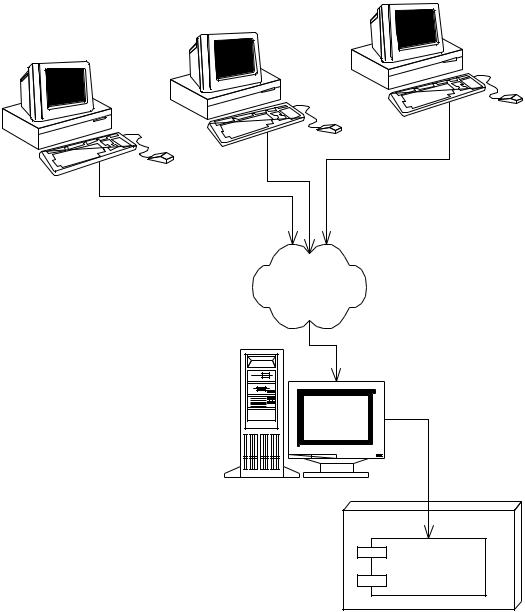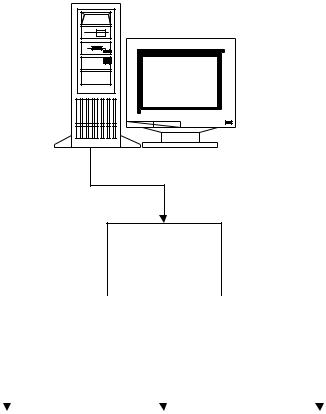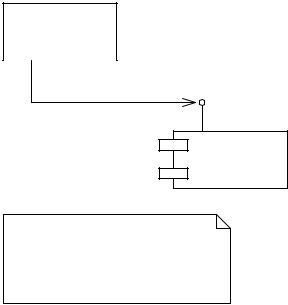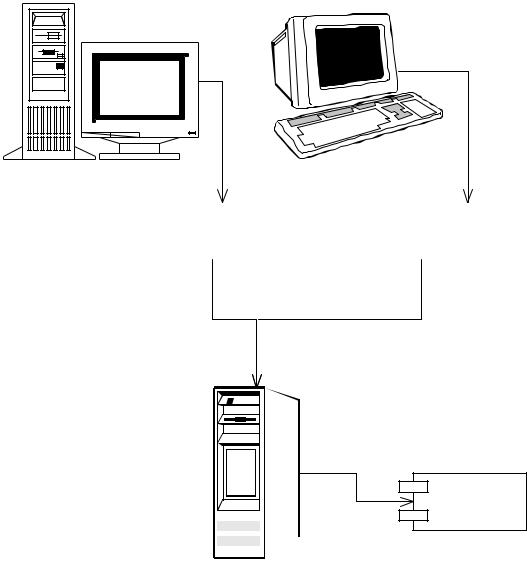
Mastering Enterprise JavaBeans™ and the Java 2 Platform, Enterprise Edition - Roman E
..pdf
Server-side Component Architectures |
|
5 |
1.The U.S. Postal Service can use the pricing component to compute shipping costs for mailing packages. This is shown in Figure 1.1.
2.An automobile manufacturer can use the pricing component to discriminate prices for cars. For example, the manufacturer can set up a Web site that allows customers to get price quotes for cars over the Internet. Figure 1.2 illustrates this scenario.
3.An online grocery store can use the pricing component as a discrete part of a complete workflow solution. When a customer purchases groceries over the Web, the pricing component first computes the price of the groceries. Next, a different vendor’s component bills the customer with the generated price. Finally, a third component fulfills the order, setting things in motion for the groceries to be delivered to the end user. We depict this in Figure 1.3.
Reusable components are quite enticing because components promote rapid application development. An IT shop can quickly assemble an application from prewritten components, rather than writing the entire application from scratch. This means:
The IT shop needs less in-house expertise. The IT shop can consider the pricing component to be a black box, and it does not need experts in complex pricing algorithms.
The application is assembled faster. The component vendor has already written the tough logic, and the IT shop can leverage that work, saving development time.
There is a lower total cost of ownership. The component vendor’s cash cow is its components, and therefore it must provide top-notch documentation, support, and maintenance if it is to stay in business. Because the component vendor is an expert in its field, the component generally has fewer bugs and higher performance than an IT shop’s home-grown solution. This reduces the IT shop’s maintenance costs.
Call into legacy system
Pricing
Component
Post Office worker |
Workstation / Dumb Terminal |
Legacy System |
Figure 1.1 Reusing a pricing component for the U.S. Postal Service.
Go back to the first page for a quick link to buy this book online!

6 |
|
M A S T E R I N G E N T E R P R I S E J A V A B E A N S |
Thus, once the rules of engagement have been laid down for how components should be written, a component marketplace is born, where vendors can sell re-usable components to companies.
Client Browser
Client Browser
Client Browser
Network
Web Server
Pricing
Component
Figure 1.2 Reusing a pricing component for quoting car prices over the Internet.
Go back to the first page for a quick link to buy this book online!

|
|
Server-side Component Architectures |
|
7 |
|
|
|
|
|
|
|
|
|
|
|
|
|
|
|
|
|
|
|
|
|
|
|
|
|
Web Server
Workflow logic
|
|
|
|
|
|
|
|
|
|
|
|
|
|
|
|
|
|
|
|
|
|
|
|
|
|
|
1: Price Order |
|
|
|
|
|
3: Fulfill Order |
|
|
||||||||
|
|
|
|
|
|
|
|
|
|
|
|||||||||||
|
|
|
|
|
|
|
|
|
|
|
|
|
|
|
|
|
|
|
|
|
|
|
|
|
|
|
|
|
|
|
|
|
|
|
|
|
|
|
|
|
|
|
|
|
|
|
|
|
|
|
2: Bill Order to customer |
|
|
|
|
|
|
|
|
||||||
|
|
|
|
|
|
|
|
|
|
|
|
|
|
|
|
|
|
|
|
|
|
|
|
|
|
|
|
|
|
|
|
|
|
|
|
|
|
|
|
|
|
|
|
|
|
|
|
|
|
|
|
|
|
|
|
|
|
|
|
||||||
|
|
Pricing |
|
|
|
|
|
|
Billing |
|
|
|
|
|
Fufillment |
||||||
|
|
|
|
|
|
|
|
|
|
|
|
|
|||||||||
|
|
|
|
|
|
|
|
|
|
|
|
||||||||||
|
|
Component |
|
|
|
|
|
Component |
|
|
|
|
|
Component |
|||||||
|
|
|
|
|
|
|
|
|
|
|
|||||||||||
|
|
|
|
|
|
|
|
|
|
|
|
|
|
|
|
|
|
|
|
|
|
|
|
|
|
|
|
|
|
|
|
|
|
|
|
|
|
|
|
|
|
|
|
Figure 1.3 Reusing a pricing component as part of an e-commerce workflow solution.
Component Architectures
To facilitate the component development process, there should be a standardized way to build, manage, and maintain components. This approach consists of the following:
Tools for developing components. The process of building components should be streamlined, allowing the component developer to focus on writing the core logic behind the component. This promotes rapid application development and is essential for any component standard to succeed. For example, an Integrated Development Environment (IDE), such as Symantec’s Visual Cafe, IBM’s VisualAge for Java, or Inprise’s JBuilder 2, assists Java developers in rapidly building and debugging components. Other vendors, such as Inline Software, provide enhanced EJB-specific development tools.
Go back to the first page for a quick link to buy this book online!
8 |
|
M A S T E R I N G E N T E R P R I S E J A V A B E A N S |
A container that manages your deployed components. This component container provides a runtime environment for your components to play in. It also provides a set of common services that most components will need. For example, the container could automatically instantiate new components as necessary, thus removing that burden from the component developer. To combine any container with any component, you must have a well-defined contract between containers and components. This contract allows any container to manage any component.
Tools for deploying and maintaining components. When an organization purchases components from component vendors, there must be a set of tools to aid in the deployment and maintenance of those components. For example, there should be a way to customize the components for a particular environment. In our pricing component example, we could have a tool that assists us in customizing the products we are pricing.
Each of these features is essential in a mainstream component marketplace. And, of course, as a component developer, you would like to focus on writing the components themselves, rather than the ancillary products that are common to all components: the container and the tools. A well-defined component architecture supplies the standards necessary for different vendors to write the components, component containers, and tools. Thus, by having a component architecture standard, developers can employ a “divide-and-conquer” approach to programming.
Java: An Ideal Language for Component Architectures
For a component to succeed in solving a business problem, both the component developer and the customer using the component must agree on the syntax and semantics of calling the component’s methods. Thus, the component vendor must publish the contract (or rules) for calling the component, and the client code must adhere to these rules.
As the vendor releases new versions of the component, that vendor’s customers will want to upgrade. This raises a number of issues. Will the new component work with the IT shop’s code that called the old component? Do the IT shops need to recompile their client code? Or, even worse, has the component contract changed, necessitating that IT shops modify their client code to map to the new component contract?
Thankfully, object-oriented design introduced a great programming practice to help solve this problem by separating the interface of a component from its implementation:
Acomponent’s interface defines the component’s contract with the code that calls it. For example, the interface defines methods and parameters that the component accepts. The interface masks the implementation from clients of
Go back to the first page for a quick link to buy this book online!

Server-side Component Architectures |
|
9 |
the component, so clients deal only with the end result: the methods the component exposes.
A component’s implementation is the core programming logic that an object provides. It has some very specific algorithms, logic, and data. This data is private to the component, and it should be hidden from all client code that calls the component.
For interface/implementation separation to be effective, developers must write client code to a component’s interface only (this is called interface-based programming). If you’re writing components, you can force developers into this paradigm by publishing only the interfaces to your components, not your implementations.
By separating interface from implementation, you can vary a component’s proprietary logic without changing any client code. For example, you can plug in a different implementation that performs the same task more efficiently. This is possible because the actual implementation is not needed at compile time—only the interface is needed. Hence, there is no specific implementation tied to the client code. This is shown in Figure 1.4.
The Java language supports interface/implementation separation at a syntactic level via the interface keyword and class keyword. And because Java is an interpreted language, the separation of code into discrete class files ensures that clients do not have to recompile their code if you ship a new version of your component.
Client
IPricer
Pricer
The Client code depends upon the
IPricer interface.
The Pricer component implements the
IPricer interface.
Figure 1.4 Interface-based programming on our pricing component.
Go back to the first page for a quick link to buy this book online!
10 |
|
M A S T E R I N G E N T E R P R I S E J A V A B E A N S |
In addition to the interface/implementation separation, Java is an object-oriented language that has been built from the ground-up as a cross-platform development language and that has wide industry support. This makes the Java language an ideal technology on which you can base components.
Component Architectures in Java
Now that you’ve seen what a component architecture is, let’s look at what component architectures exist in the Java world. The first one you may have heard of is JavaBeans. JavaBeans components are small-grained application bits. You can use JavaBeans to assemble larger-grained components or to build entire applications. JavaBeans, however, are development components and are not deployable components. You typically do not deploy a JavaBean because a JavaBean is not a complete application; rather, JavaBeans help you construct larger software that is deployable. And because they cannot be deployed, JavaBeans do not need a runtime environment in which to live. JavaBeans do not need a container to instantiate them, to destroy them, and to provide other services to them because the application itself is made up of JavaBeans.
By way of comparison, the Enterprise JavaBeans (EJB) standard defines a component architecture for deployable components called enterprise beans. Enterprise beans are larger, coarser-grained application components that are ready to be deployed. They can be deployed as is, or they can be assembled with other components into larger application systems. Deployable components must be deployed in a container that provides runtime services to the components, such as services to instantiate components as needed.
Enterprise beans are very similar to two other types of Java components: applets and servlets. Applets can be deployed in a Web page, where the browser’s applet viewer provides a runtime container for the applets. Servlets can be deployed in a Web server, where the Web server’s servlet engine provides a runtime container for the servlets. Enterprise beans are deployed in an application server, where the application server provides a runtime container for the Enterprise JavaBeans. This is shown in Figure 1.5.
The real difference between applets, servlets, and enterprise beans is the domain of which each component type is intended to be a part.
Applets are portable Java programs that can be downloaded on the fly and can execute in an untrusting environment. For example, an applet can be downloaded from a Web server into a Web browser, and it typically displays a user interface to the end user.
Servlets are networked components that you can use to extend the functionality of a Web server. Servlets are request/response oriented, in that they take requests from some client host (such as a Web browser) and issue a response
Go back to the first page for a quick link to buy this book online!

|
|
Server-side Component Architectures |
|
11 |
|
|
|
|
|
|
|
|
|
|
|
|
|
|
|
|
|
|
|
|
|
|
|
|
|
Java-enabled Web Browser
Web Server with Servlet Engine
(Applets downloaded from a Web Server)
|
|
Servlets |
|
|
|
Applets |
|
|
|
|
|
||
|
|
|
|
|
||
|
|
|
|
|
|
|
|
|
|
|
|
|
|
|
|
|
|
|
|
|
Enterprise
JavaBeans
Application Server with Component Container
Figure 1.5 Applets, servlets, and Enterprise JavaBeans.
back to that host. This makes servlets ideal for performing Web tasks, such as rendering an HTML interface to an e-commerce catalog.
Both applets and servlets are well suited to handle client-side operations, such as rendering graphical user interfaces (GUIs) (although they don’t necessarily need to have one), performing other presentation-related logic, and lightweight business logic operations. The client side could be a Web browser, in the case of applets
Go back to the first page for a quick link to buy this book online!
12 |
|
M A S T E R I N G E N T E R P R I S E J A V A B E A N S |
that render user interfaces using the Java Foundation Classes. The client side could also be a Web server, in the case of servlets that render user interfaces in HTML. In both these situations, the components are dealing directly with the end user.
Enterprise beans, on the other hand, are not intended for the client side, but are server-side components. They are meant to perform server-side operations, such as executing complex algorithms or performing high-volume business transactions. The server side has different kinds of needs from a rich GUI environment. Server-side components need to run in a highly available (24x7), faulttolerant, transactional, and multiuser secure environment. An application server provides this high-end server-side environment for the enterprise beans, and it provides the runtime containment necessary to manage enterprise beans.
Finally, note that applets, servlets, and enterprise beans are not “either-or” technologies. You can use JavaBeans as development component building blocks for constructing deployable enterprise beans. You can also provide a user interface to your enterprise beans with applets or servlets (shown in Figure 1.5).
Now that you’ve seen where EJB fits in with other technologies, let’s take a look at the class of problems that EJB addresses. EJB is meant for server-side programming; to appreciate what EJB brings to the table, we must first understand what makes server-side programming difficult.
The Needs of the Server Side
As we’ve mentioned, a complete component architecture paves the way for the following:
■■Developers to write reusable components
■■Vendors to write component containers that provide a runtime environment and services to components
■■Vendors to provide development, deployment, and maintenance tools, which are necessary complements to the components themselves
This divide-and-conquer approach allows vendors to provide a set of common services that most components will need, thus saving precious development and deployment time. Rather than reimplement the wheel, the component developer can simply outsource the services he needs to other products. Professionals who are experts in providing these services write these products. When harnessed properly, users save time by buying rather than building. Additionally, the overall deployment is strengthened because domain experts are writing these common products.
As we’ll see, server-side software opens up a whole new set of problems that require some very high-end services. If you choose to home-grow these services
Go back to the first page for a quick link to buy this book online!
Server-side Component Architectures |
|
13 |
yourself, you’ll likely encounter a development and maintenance nightmare. Being able to outsource server-side services is one of the key benefits of a serverside distributed object architecture like EJB.
Multi-tier Architectures
A server-side deployment is software written to support concurrent users performing operations simultaneously, securely, reliably, and efficiently. Examples of server-side deployments include the following:
Banks where many ATM machines connect to a central bank server
Retail outlets such as the Wal-Mart chain of stores, where many Wal-Mart stores send shopping information to a central Wal-Mart server
Support centers where support engineers have terminals that can bring up customer data from a central server
Insurance agencies where insurance sales staff have terminals that connect to a central server
Web sites where thousands or millions of users connect to Web servers and those Web servers need to connect with a central server for data and logic
Robust server-side deployments are not easy to build. Many issues arise, such as scalability, maintainability, security, reliability, and more. With so many clients depending on your central server-side deployment, it would be a catastrophe if your central servers went down, slowed to a crawl, or allowed a hostile party to gain access to the systems. Therefore, server-side deployments need to be well written from the ground up and well tested, and they need to run in a robust environment.
Any well-written deployment has a logical software partitioning into layers. Each layer has a different responsibility in the overall deployment, and within each layer there can be one or more components. Note that these layers are purely abstractions, and they may not correspond to physical distribution. A layered system is a well-designed system because each layer is responsible for a separate task. Here is a typical layer partitioning:
A presentation layer contains components dealing with user interfaces and user interaction. For example, the presentation layer of a stand-alone application could be written in Visual Basic. The presentation layer of a Web-based deployment could use Java servlets, Java server pages, and/or Java applets.
A business logic layer contains components that work together to solve business problems. These components could be high-performance engines, such as catalog engines or pricing engines. Typically, these components are written in a type-safe language such as Java or C++.
Go back to the first page for a quick link to buy this book online!
14 |
|
M A S T E R I N G E N T E R P R I S E J A V A B E A N S |
A data layer is used by the business logic layer to persist state permanently. Central to the data layer is one or more databases that house the stored state.
The advantage to partitioning an application into these logical layers is to isolate each layer from the others. For example, it should be possible to plug in a different view (i.e., change the presentation layer) while minimizing impacts on the business logic or data layers. It should similarly be possible to plug in a different set of business rule component implementations within your business logic layer, or to plug in a different database in your data layer, with relatively minor effects on the other layers. In some ways, this is analogous to how the classic model-view-controller separation allows the developer to vary the model, view, and controller independently of one another.
The physical separation of these layers is another story. In a two-tier architecture, two of these layers are physically separated from the third, forming two physically separated tiers. On the other hand, a three-tier architecture separates each of these three abstract, logical layers into three physically distributed tiers. In each of these architectures, the tiers are separated from one another by some physical boundaries, such as machine boundaries, process boundaries, or corporate boundaries. In the discussion that follows, we don’t really care what the boundary is—it could be a process boundary, a machine boundary within a local area network, or a boundary across the Internet. And for clarity, we will refer to all deployments with three tiers or more as N-tiered, which is used interchangeably with three-tiered occasionally.
So what are the advantages to separating your application into two tiers verses N tiers? There are a number of compelling reasons for both sides, which we’ll soon uncover. From this debate, you will begin to see the needs of the server side and why a distributed server-side architecture such as Enterprise JavaBeans is necessary.
Two-Tier Architectures
Traditionally, most high-end deployments have been two-tiered. Two-tier deployments combine the business logic layer with one of the other two layers. There are two combinations possible: combining the presentation layer with the business logic layer, and pushing some of the business logic layer into the data layer. Let’s take a look at each scenario.
Combining the Presentation Layer with the Business Logic Layer
Your presentation layer and business logic layer can be coupled together in a single tier, pushing the data access layer into a tier by itself. This draws a tier boundary between the business logic layer and the data layer (Figure 1.6). If you think of the first tier as a “client” and the second tier as a “server,” this architecture effectively makes the client “fat” and the server “thin.”
Go back to the first page for a quick link to buy this book online!
